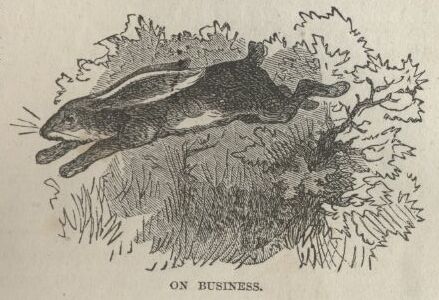By and by we passed through Marysville, and over the Big Blue and [Little Sandy; thence about a mile, and entered Nebraska. About a mile further on, we came to the Big Sandy]—one hundred and eighty miles from St. Joseph.
[12.18–19 Little Sandy . . . Big Sandy] Actually, the trail crossed Little Sandy Creek about twenty-five miles beyond the Nebraska border, and then, another three miles or so further on, Big Sandy Creek. Clemens’s memory of this section of the route was not helped by Orion’s journal, which made no mention of the river crossings Chapter 3: note for 12.18–19," in Roughing It : an electronic text. 2016 ]
As the sun was going down, we saw the first specimen of an animal known familiarly over two thousand miles of mountain meditation.and desert—from Kansas clear to the Pacific Ocean—as the “jackass rabbit.” He is well named. He is just like any other rabbit, except that he is from [one-third] to twice as large, has longer legs in proportion to his size, and has the most preposterous ears that ever were mounted on any creature but a jackass. When he is sitting quiet, thinking about his sins, or is absent-minded or unapprehensive of danger, his majestic ears project above him conspicuously; but the breaking of a twig will scare him nearly to death, and then he tilts his ears back[begin page 13]gently and starts for home. All you can see, then, for the next minute, is his long gray form stretched out straight and “streaking it” through the low sage-brush, head erect, eyes right, and ears just canted a little to the rear, but showing you where the animal is, all the time, the same as if he carried a jib. Now and then he makes a marvelous spring with his long legs, high over the stunted sage-brush, and scores a leap that would make a horse envious. Presently he comes down to a long, graceful “lope,” and shortly he mysteriously disappears. He has crouched behind a sage-bush, and will sit there and listen and tremble until you get within six feet of him, when he will get under way again. But one must shoot at this creature once, if he wishes to see him throw his heart into his heels, and do the best he knows how. He is frightened clear through, now, and he lays his long ears down on his back, straightens himself out like a yard-stick every spring he makes, and scatters miles behind him with an easy indifference that is enchanting.
 Our party made this specimen “hump himself,” as the conductor said. The [Secretary] started him with a shot from the Colt; I commenced spitting at him with my weapon; and all in the same instant the old “Allen’s” whole broadside let go with a rattling crash, and it is not putting it too strong to say that the rabbit was frantic! He dropped his ears, set up his tail, and left for San Francisco at a speed which can only be described as a flash and a vanish! Long after he was out of sight we could hear him whiz.
Our party made this specimen “hump himself,” as the conductor said. The [Secretary] started him with a shot from the Colt; I commenced spitting at him with my weapon; and all in the same instant the old “Allen’s” whole broadside let go with a rattling crash, and it is not putting it too strong to say that the rabbit was frantic! He dropped his ears, set up his tail, and left for San Francisco at a speed which can only be described as a flash and a vanish! Long after he was out of sight we could hear him whiz.
"Chapter 3: Paragraph 15," in Roughing It
See Burton 8th August to Rock Creek and The Valley of the Little Blue, August 9th
See Burton Native Americans in the Nebraska Territory